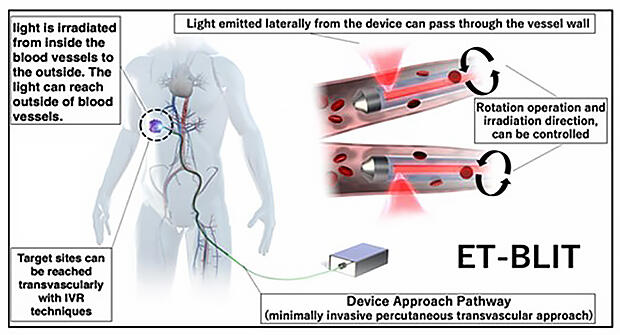A research group consisting of Designated Lecturer Kazuhide Sato of the Graduate School of Medicine/Medical Engineering Unit Frontier, Institute for Advanced Research, Nagoya University, former researcher Toshihiko Tsukamoto of Asahi Intecc, and their colleagues, has announced the development of "ET-BLIT (Endovascular Therapy-Based Light Illumination Technology)," a therapy device and light illumination system that uses interventional radiology (IVR) for myocardial infarction and other diseases.
The group has succeeded in developing a narrow device that can reach the entire body via the blood vessels. Using an animal experiment, they confirmed that light irradiated from the blood vessels can effectively and safely reach exterior tissues. It is hoped that these outcomes will lead to new cancer therapy technologies, such as near-infrared immunotherapy. The group's outcomes were published in the October 5 edition of the international science journal eBioMedicine.

Provided by Nagoya University
Near-infrared immunotherapy is a cancer treatment method. It involves administering photosensitive complexes and antibodies that specifically recognizing and binding to proteins expressed by cancer cells, with the goal of destroying only cancerous cells through irradiating them with infrared light (around 690 nm) Dr. Hisataka Kobayashi of the National Cancer Institute in the U.S. and his colleagues reported this method in 2011. It has attracted attention as a new form of cancer treatment, and in 2020 was accepted and covered by health insurance in Japan for recurring cases of previously treated cancer of the head and neck in which the cancer target protein EGFR has a high level of expression.
On the other hand, it was difficult to apply this therapy method to cancers deep in the body, such as the brain, because it is only effective in areas illuminated by light. Moreover, research on this therapy method was mainly focused on drugs, such as photosensitizers, and the development of devices to irradiate near-infrared light was inadequate.
Previously, in 2018, the research group clarified that the cancer cell death mechanism that results from this treatment is caused by a photochemical reaction. This time, the research group made use of endovascular therapy technology applied to myocardial infarctions and cerebral infarctions, with the aim of broadening its applications for cancers in the deep parts of the body. They developed ET-BLIT, which can reach cancerous areas from the blood vessels that run around the inside of the body.
This system and device is made up of a catheter, guidewire and a diffuser. Areas are illuminated by near-infrared light via the diffuser's optical fiber according to the operator's wishes. Using this device could ensure effective delivery of light to tissues that cannot be reached by light irradiated outside of the body, using the same method as regular endovascular therapy.
In evaluations carried out via an animal experiment using a pig, which is genetically similar to a human, the group was able to confirm that the light illumination is highly effective, highly selective and safe for tissues outside of the blood vessels. More specifically, the diffuser was inserted into target deep blood vessels (renal artery, coronary artery), and irradiated near-infrared light in the same manner as IVR. An incision was made in the abdominal cavity and the light transmitted to the internal organs was measured in energy.
The outcomes confirmed light transmission to the internal organs. Moreover, the group was able to confirm that there were no issues such as temperature increases, blood vessel damage or changes in blood components.
Sato commented, "Endovascular therapy is currently widely used around the world, so we think that any hurdles to the commercialization of the newly developed ET-BLIT will be low. We will work towards further optimization, continuing our fundamental studies with regard to clinical trials, and aim for ET-BLIT's clinical application as a next-generation device used for therapy via commercialization."
Journal Information
Publication: eBioMedicine
Title: Inside-the-body light delivery system using endovascular therapy-based light illumination technology
DOI: 10.1016/j.ebiom.2022.104289
This article has been translated by JST with permission from The Science News Ltd.(https://sci-news.co.jp/). Unauthorized reproduction of the article and photographs is prohibited.




